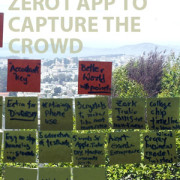How Arts Organizations Are Engaging Community Online
In the San Francisco Online Community Meetup panel hosted by TechSoup, representatives from four arts organizations discussed how they are using social media in new and innovative ways to market the arts.
Michel DeLong, online community manager at TechSoup and part of the leadership team with Emerging Arts Professionals, moderated the discussion. Panelists included:
• Danielle Siembieda, former community engagement and special projects manager for ZERO1: The Art & Technology Network in San Jose, CA.
• Maura Lafferty, an independent communications consultant working with classical musicians and performing arts organizations in San Francisco, CA.
• Dan Meager, director of marketing at Diablo Ballet in Walnut Creek, CA.
• Carly Severn, digital engagement associate at San Francisco Ballet in San Francisco, CA.
Art & Social Media: Case Studies
Danielle Siembieda (@art_inspector) created a project called Art Ambassadors. She started this project as a response to the commonly heard statement, “I just don’t get art”. Its purpose was to train students to experiment with, understand, and share art using social media and face-to-face interaction. As part of the marketing campaign for the 2012 ZERO1 Biennial, it also functioned as a professional development program in arts administration. An interactive map app was also collaboratively created by the community as a social experiment to facilitate user experience. Through this project, she bridged the gap between curator and audience using the essential component of social media: technology.
Dan Meager (@DiabloBallet) used Twitter to crowdsource the first ballet work created from the Internet with the goal of making classical art forms more relevant. Highlighted on the Huffington Post, this social media project invited the Twitterverse to submit ideas for everything related to the performance: concept, mood, even the moves of the dancers. Meager also used YouTube to crowdsource the score of the dance. The Diablo Ballet used social media and received media attention on The San Francisco Chronicle and the Huffington Post without a $5 million budget. As Meager mentioned, while the ROI of social media is hard to define – the broad exposure social media brings to the arts is well worth the work.
Maura Lafferty (@mlaffs) introduced a new digital asset community managers could use to measure ROI. The new app, Awe.sm, correlates social media data with revenue at a low monthly cost. As a “Chief Happiness Officer” because she sees community managers as the liaison between the audience and the strategic goals of the client or organization–ensuring everyone is happy. This can be difficult in the arts, where audiences’ values can differ greatly. Take her specific case: marketing classical music to a generally younger audience on social media channels. Lafferty communicates strategically by finding out how values from different audiences relate. This involves constant monitoring to gain a fluency in the dynamic trends of social media.
Carli Severn (@teacupinthebay) hit the nail on the head. In the performing arts, the audience is your lifeblood. When arts organizations are creating strategies around audience development, they must first know who their audience is. Severn spearheaded a new marketing initiative for the San Francisco Ballet that used social media to grow audiences through a series of contests. Using Twitter, Instagram, Tumblr, Instagram, Pinterest, Twitter , Facebook, and WordPress, she cross-promoted The Nutcracker by offering special seats to contest winners. Knowing the audience was for each platform proved to be effective. Because of this social media campaign, the Nutcracker is seen as a local tradition.
As arts organizations across the globe begin to recognize the the value of social media as an integrated marketing and communications tool, the role of community manager will inevitably grow. These panelists have demonstrated innovative strategies for using social media to interact with and grow audiences in the arts.







Leave a Reply
Want to join the discussion?Feel free to contribute!